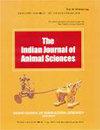Ultrasound-guided versus blind intraarticular injection of the foot of Egyptian buffaloes (Bubalus bubalis): A pilot study
IF 0.3
4区 农林科学
Q4 AGRICULTURE, DAIRY & ANIMAL SCIENCE
引用次数: 0
Abstract
This study was designed to compare the effectiveness of US-guided and blind IA injection techniques of buffaloes foot. Twenty adult buffalo cadaveric hind feet were randomly assigned to blind (n=10) and US-guided (n=10) injections of the fetlock, pastern, and coffin joints. Methylene blue (1%) and Iopamidol® 300 (5 ml) were used as indicative markers for IA injection. The same injection strategy was also used in vivo on 10 live sound buffaloes. The injection criteria were comparatively evaluated between the two injection techniques. The US-guided injection technique showed a significant increase in the injection parameters of the fetlock, pastern, and coffin joints in the foot of buffaloes compared with the blind technique. However, the difficulties of the injection and several trials weresignificantly higher in the blind IA injection than in the US-guided injection. The performance time was significantly shorter with the US-guided injection as compared to blind IA injection. Compared to the blind approach, US-guided injection had the highest specificity for intra-articular injection procedures at 86.66%. In conclusion, US-guided IA injection of buffaloes feet showed promising results in enhancing the quality of diagnostic and therapeutic IA injections compared to blind injections.超声引导下对埃及水牛(Bubalus bubalis)足部关节内盲注射:一项初步研究
本研究旨在比较us引导和盲法注射水牛足内注射技术的有效性。20只成年水牛尸体后脚被随机分配到盲(n=10)和US-guided (n=10)注射felock,骹骨和棺材关节。以亚甲蓝(1%)和Iopamidol®300 (5 ml)作为IA注射的指示性标记物。同样的注射策略也在10头活水牛身上使用。对两种注射方法的注射标准进行了比较评价。与盲法相比,US-guided injection technology在水牛足部的felock、骹骨和coffin关节的注射参数显著增加。然而,注射的困难和几项试验在盲注射IA明显高于在美国引导注射。与盲目注射IA相比,us引导注射的表现时间显着缩短。与盲入路相比,us引导注射对关节内注射的特异性最高,为86.66%。总之,与盲注射相比,美国引导下的水牛足内注射在提高诊断和治疗性内注射质量方面显示出有希望的结果。
本文章由计算机程序翻译,如有差异,请以英文原文为准。
求助全文
约1分钟内获得全文
求助全文
来源期刊

Indian Journal of Animal Sciences
农林科学-奶制品与动物科学
CiteScore
0.60
自引率
25.00%
发文量
220
审稿时长
8 months
期刊介绍:
Articles published in The Indian Journal of Animal Sciences encompass a broad range of research topics in animal health and production related to cattle, buffalo, sheep, goat, camel, equines, pig, rabbit, yak, mithun, poultry and fisheries. Studies involving wildlife species and laboratory animal species that address fundamental questions about their biology will also be considered for publication. All manuscripts must present some new development and must be original, timely, significant and scientifically excellent. Papers will be rejected if standards of care of, or procedures performed on animals are not up to those expected of humane veterinary scientists. At a minimum, standards must meet the International Guiding Principles for Biomedical Research involving Animals, as issued by the Council for International Organizations of Medical Sciences. (C.I.O.M.S., c/o WHO, CH 1211 Geneva 27, Switzerland). Articles reporting new animal disease must follow GOI directive as given in detail in Guidelines to Authors.
 求助内容:
求助内容: 应助结果提醒方式:
应助结果提醒方式:


